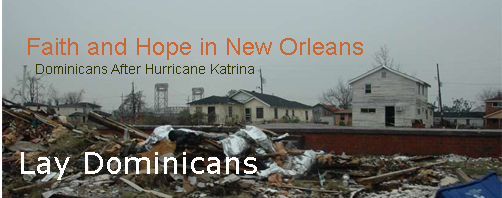
A Beacon of Hope Lights the Road
to Recovery in
New Orleans
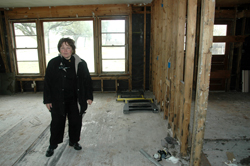 |
| Linda Pippinger,
OPL, stands inside a Lake View house devasted by Hurricane
Katrina |
Like a mythological phoenix rising from the ashes of desperation
and despair, the city of New Orleans is slowly and painfully
starting to heal in the wake of Hurricane Katrina. Seventeen
months after the failure of the levees and pumping stations
caused the devastation of eighty to eighty-five percent
of the entire city, there are still hundreds of square
miles of gutted houses and abandoned neighborhoods. Even
though there is a trickle of residents who are starting
to return, it is estimated that there are roughly 175,000
former inhabitants who have not yet come back. Many evacuated
homeowners who still have jobs in the city commute long
distances on a daily basis. “They might think about
moving back, but when they look at the conditions of their
old neighborhoods, they realize that they really do not
even know where to begin,” said homeowner John Pippinger.
John and his wife Linda, a Lay Dominican
and member of St. Dominic Chapter, New Orleans,
are members of Beacon
of Hope.
Many property owners have simply given up and
relocated elsewhere to begin new lives.
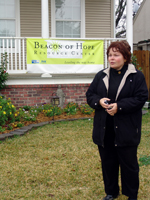 |
| Linda Pippinger,
OPL, member of Beacons of Hope and New Orleans resident |
Established in the months immediately following the devastating
storm, The Beacon
of Hope Resource Center raises the hopes
and quality of life for these desperate families by providing
information and resources to help them rebuild. Founded
by Lakewood South homeowners Denise and Doug Thornton,
flood survivors themselves, Beacon of Hope was chartered
to “assist all New Orleans homeowners in rebuilding
and restoring their homes and communities.” Today,
Beacon of Hope has branched out from the Thorntons’ flood-damaged
home to eight satellite locations concentrated within the
Lakeview district of New Orleans.
As a non-profit organization entirely dependent on volunteers
and donations, Beacon of Hope takes a grassroots approach
to rebuilding the city. By improving general neighborhood
conditions first, property owners will be encouraged to
consider returning and working on their individual properties.
The first group of Beacon volunteers to enter an abandoned
neighborhood is there to pick up debris, mow lawns, remove
dead trees, and improve the general appearance of the area. “It
mentally impacts people when they look at their yards and
see the tires, storm debris and garbage all cleaned up,
and they kind of step back and think to themselves, well
maybe, just maybe, I can come back,” said Lori Bird
, Co-Administrator of the St. Paul Beacon, during a recent
orientation session for high school volunteers. Bird added, “By
cleaning up the neighborhood, we are also sending a message
to criminals [looters] that — hey, something is going
on here, people live here.”
The Beacon volunteers also perform “block surveys” which
are assessments of the conditions of individual houses,
neighborhood infrastructure (sidewalks, streets, manholes,
trees and landscaping, fire hydrants, abandoned vehicles,
etc.), street lighting, and the city water and sewer system.
The surveys are then passed along to property owners and
city officials to give them a starting reference for what
needs to be repaired or replaced.
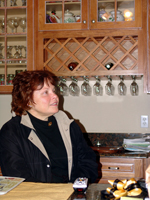 |
| Linda shares her newly renovated home |
According to Beacon Satellite Administrator Linda Peppinger,
the obstacles facing the returning residents are many. “Toxic
flood debris everywhere, no utilities, wind and water damage
to building structures, mildew and mold growth and a lack
of basic services like mail delivery and telephone,” she
said. Peppinger and her husband John, their children and
their families were all living within a four-square mile
area of the Lakeview district when Katrina hit. Each family
member’s home was seriously damaged or destroyed,
and Linda and John were forced to cash in their retirement
and life savings to purchase another, less severely damaged
home and rebuild it. Now the Peppinger family members are
living under one roof until the children can re-establish
themselves. “No one ever thought that it was going
to be this bad. When we left [evacuated], we thought, we’ll
be back in a few days and clean up, and everything will
be all right,” Peppinger said. So far Linda and John
have made no decision as to what they will do with their
original home.
Another obstacle to drawing the residents back to the
city has been the poor administration and distribution
of relief funds and services that would allow the homeowners
to repair the damage to their properties. One of the major
relief initiatives, dubbed the Louisiana Road Home Program,
was developed by Louisiana Governor Kathleen Babineaux
Blanco in conjunction with the Louisiana Recovery Authority
and the Office of Community Development. The program was
designed to allow eligible homeowners up to $150,000 in
compensation to cover their losses and help them get back
into their homes. Critics are quick to point out that in
2006, the $756 million contract with ICF International
of Fairfax, Virginia, to manage the funds produced only
about $176 million in revenue and only 177 people out of
99,000 applicants have been awarded grants. The abysmal
figure represents a response rate that is only .0079 percent
of the total that applied. “It is a complete breakdown
of the infrastructure,” John Peppinger said. “The
state government is bogged down by bureaucracy and is not
distributing the Road Home money, and the city government
has taken a wait-and-see attitude about everything else.” Beacon
of Hope offers residents assistance in identifying the
relief programs that are available to them and information
on completing each of the application processes.
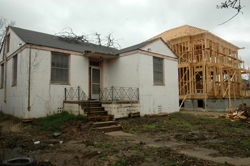 Besides offering the initial cleanup and damage assessment
services and assistance in obtaining relief aid and grants,
The Beacon of
Hope Resource Center offers a variety of
additional services to recovering communities in New Orleans.
These include providing information on how residents can
obtain construction licenses and permits, negotiate contracts,
and inspect for and remove mold, to actually acting as
a communication link between residents and city agencies
in restoring services and utilities, such as electricity,
mail delivery, telephone, cable, sewage and water, and
trash removal. The Resource Center has also developed a
referral service for licensed and approved builders, plumbers,
electricians, alarm and communication technicians, pool
cleaners, landscapers and other skilled professionals.
Besides offering the initial cleanup and damage assessment
services and assistance in obtaining relief aid and grants,
The Beacon of
Hope Resource Center offers a variety of
additional services to recovering communities in New Orleans.
These include providing information on how residents can
obtain construction licenses and permits, negotiate contracts,
and inspect for and remove mold, to actually acting as
a communication link between residents and city agencies
in restoring services and utilities, such as electricity,
mail delivery, telephone, cable, sewage and water, and
trash removal. The Resource Center has also developed a
referral service for licensed and approved builders, plumbers,
electricians, alarm and communication technicians, pool
cleaners, landscapers and other skilled professionals.
Volunteers at the Resource Center also provide mental
health services for children and adults, assistance for
the elderly, free notary public rendering services, pet
registration, neighborhood watch resources, rodent and
insect control resources, FEMA referral information, and
assistance in applying for Increased Cost of Compliance
funds (ICC). Among the major supporters of Beacon of Hope
are Ray Woolridge (former owner of the New Orleans Hornets
basketball team), United Way, Blue Moon Fund, The Woldenberg
and Goldring Family foundations, and Catholic Charities.
The long-range strategy for The Beacon of Hope Resource
Center is to eventually expand out of the Lakeview district
and to bring neighborhoods in other areas of the city back
one at a time, in the hope that as the recovered neighborhoods
start to normalize, they will reach out to surrounding
areas until every community has been helped. The most successful
element that has made Beacon of Hope a reality is the winning
combination of hard-working local and visiting volunteers,
along with a core of dedicated donors. With this winning
formula, the Center will undoubtedly keep bringing the
citizens of New Orleans back to their neighborhoods, eventually
healing their broken city. “Without our volunteers
and contributors we would have nothing. They are our silver
lining. God bless them for all that they have done for
us,” Linda Peppinger concluded.
The Beacon of Hope Resource Center is located at 319 W.
Harrison Avenue, New Orleans, LA 70124. Telephone: (504)
872-9873. Web: www.lakewoodbeacon.org.
Chris Barecki, Communications Office
Dominican Sisters of Adrian
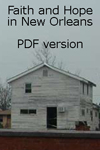
 Can't
open PDF format files? Click on the link to download the latest Adobe
Reader. It is safe and secure and free. Really.
Can't
open PDF format files? Click on the link to download the latest Adobe
Reader. It is safe and secure and free. Really.


